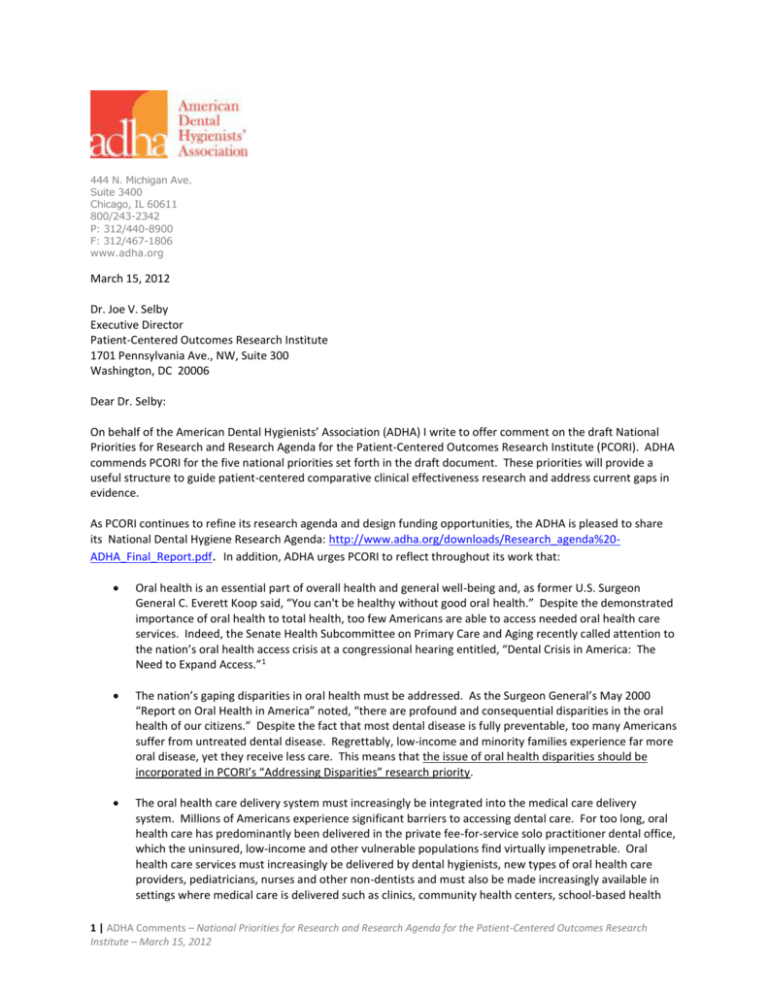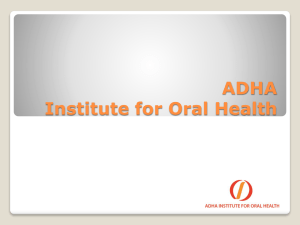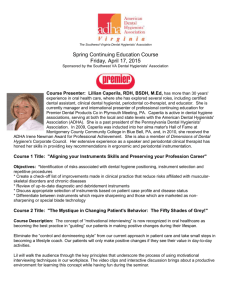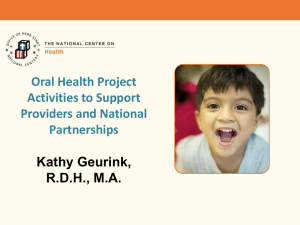ADHA-PCORI-Comments-March
advertisement

444 N. Michigan Ave. Suite 3400 Chicago, IL 60611 800/243-2342 P: 312/440-8900 F: 312/467-1806 www.adha.org March 15, 2012 Dr. Joe V. Selby Executive Director Patient-Centered Outcomes Research Institute 1701 Pennsylvania Ave., NW, Suite 300 Washington, DC 20006 Dear Dr. Selby: On behalf of the American Dental Hygienists’ Association (ADHA) I write to offer comment on the draft National Priorities for Research and Research Agenda for the Patient-Centered Outcomes Research Institute (PCORI). ADHA commends PCORI for the five national priorities set forth in the draft document. These priorities will provide a useful structure to guide patient-centered comparative clinical effectiveness research and address current gaps in evidence. As PCORI continues to refine its research agenda and design funding opportunities, the ADHA is pleased to share its National Dental Hygiene Research Agenda: http://www.adha.org/downloads/Research_agenda%20ADHA_Final_Report.pdf. In addition, ADHA urges PCORI to reflect throughout its work that: Oral health is an essential part of overall health and general well-being and, as former U.S. Surgeon General C. Everett Koop said, “You can't be healthy without good oral health.” Despite the demonstrated importance of oral health to total health, too few Americans are able to access needed oral health care services. Indeed, the Senate Health Subcommittee on Primary Care and Aging recently called attention to the nation’s oral health access crisis at a congressional hearing entitled, “Dental Crisis in America: The Need to Expand Access.”1 The nation’s gaping disparities in oral health must be addressed. As the Surgeon General’s May 2000 “Report on Oral Health in America” noted, “there are profound and consequential disparities in the oral health of our citizens.” Despite the fact that most dental disease is fully preventable, too many Americans suffer from untreated dental disease. Regrettably, low-income and minority families experience far more oral disease, yet they receive less care. This means that the issue of oral health disparities should be incorporated in PCORI’s “Addressing Disparities” research priority. The oral health care delivery system must increasingly be integrated into the medical care delivery system. Millions of Americans experience significant barriers to accessing dental care. For too long, oral health care has predominantly been delivered in the private fee-for-service solo practitioner dental office, which the uninsured, low-income and other vulnerable populations find virtually impenetrable. Oral health care services must increasingly be delivered by dental hygienists, new types of oral health care providers, pediatricians, nurses and other non-dentists and must also be made increasingly available in settings where medical care is delivered such as clinics, community health centers, school-based health 1 | ADHA Comments – National Priorities for Research and Research Agenda for the Patient-Centered Outcomes Research Institute – March 15, 2012 centers, pediatrician’s offices, and other non-traditional settings. A patient’s health home should incorporate highly coordinated, patient-centered medical and dental care. The dental safety net is woefully inadequate, and there simply is no “dental emergency room.” As the Pew Center on the States reported recently, “lack of access to dental care has led to more and more people entering hospital emergency rooms with preventable dental conditions. In 2009 preventable dental conditions were the primary diagnosis in more than 830,000 visits to emergency rooms…. Furthermore, hospitals are generally unable to treat conditions such as dental abscesses and toothaches, which means that many patients who leave without the underlying dental problem address often return to the ER later as their condition deteriorates.” 2 PCORI’s research on improving health systems should examine more efficient ways to provide dental care. Set forth below is further information that underscores the importance of including oral health and oral health care providers as integral parts of any national health research agenda. Oral Health is Vital to Total Health and Most Dental Disease is Preventable Yet Too Few Americans Fully Appreciate the Importance of Oral Health - This Means that PCORI Communication and Dissemination Research Should Compare the Effectiveness of Both Traditional and Innovative Ways to Accelerate Progress in Elevating the Nation’s “Oral Health IQ” Research is continually emerging that demonstrates the link between oral health and total health. The Centers for Disease Control has noted the relationship between periodontal disease and health problems like diabetes, heart disease, and strokes.3 The tragic death of 12 year old Deamonte Driver who died in 2007 as a result of complications from a brain infection that was brought about by an abscessed tooth was an unfortunate demonstration of the impact of untreated oral disease and the serious – even fatal – consequences of lack of access to dental care. While most oral disease is completely avoidable with proper preventive care, oral disease rates among children and adults continue to climb.4, 5 Preventing oral disease can positively impact total health and is also cost effective. Research indicates that low-income children who have their first preventive dental visit by age one incur dental related costs that are approximately 42 percent lower ($262 before age one, $449 between ages two and three) over a five year period than children who receive their first preventive between the ages of two and three. 6 Preventive care can diminish the need for more costly restorative and emergency care, saving valuable health care dollars in the long-run. Further, too many Americans fail to realize that dental caries (tooth decay) is an infectious transmissible disease typically passed from mother or caregiver to very young children. Clearly, more effective methods of educating pregnant women as well as parents and other caregivers of young children are in order. Dental Hygienists are Primary Providers of Oral Health Care Services and Are Increasingly Providing Restorative Oral Health Services. – PCORI’s Research on Improving Healthcare Systems Should Incorporate Examination of Increasing Utilization of Non-Dentist Providers for Oral Health Services, Including Mid-Level Dental Providers Such as Advanced Dental Therapists in Minnesota ADHA is pleased to see that PCORI has highlighted the importance of improving healthcare systems across the country, and that PCORI has noted the dearth of research in this arena, drawing attention to the fact that “healthcare systems at all levels lack evidence on the most effective strategies to support patients in obtaining the outcomes they desire.” Under 2.B. on page 17, the PCORI draft document further expresses interest in “research that compares the effectiveness on patient outcomes of a wide range of system-level strategies to incorporate new and extended roles for allied health professionals. The ADHA is pleased that PCORI is focusing attention on the healthcare workforce. It is essential that the appropriate supply, mix, distribution, and diversity of health care providers be promoted and that health care providers are utilized to the full extent of their ability. The ADHA calls attention to the increasing trend across the nation to better utilize the experience, education and expertise of dental hygienists. The dental hygienist is the member of the oral health care team focused on 2 | ADHA Comments – National Priorities for Research and Research Agenda for the Patient-Centered Outcomes Research Institute – March 15, 2012 preventing oral disease and identifying and treating oral disease while it is still manageable. Dental hygienists are primary care oral health professionals who administer a range of oral health services including prophylaxis (cleaning), sealants, fluoride treatments, oral cancer screenings, oral health education, and in many states dental hygienists play an active role in placing restorations. 7 Dental hygienists work in a host of settings to deliver clinical care and work under varying levels of supervision, depending on the state practice act. States are increasingly recognizing the importance of increasing direct access to dental hygiene services. In 1995, five states allowed direct access. In 2000, nine states allowed direct access. Today, in 35 states, dental hygienists are able to initiate patient care in public health settings, like schools, nursing homes, and public clinics, without the presence or specific authorization of a dentist. 8 These states recognize that dental hygienists are primary care providers who are an essential entry point to the health care system. This direct access to dental hygiene services is especially critical for vulnerable populations like children, the elderly, and the geographically isolated who often struggle to overcome transportation, lack of insurance coverage, and other barriers to oral health care. In 1998, California and Washington became the first states to recognize and reimburse hygienists as Medicaid providers. Today, 15 states (Arizona, California, Colorado, Connecticut, Maine, Massachusetts, Minnesota, Missouri, Montana, Nebraska, Nevada, New Mexico, Oregon, Washington and Wisconsin) recognize and reimburse hygienists as Medicaid providers. 9 HRSA’s National Center for Health Workforce Analysis developed the Dental Hygiene Professional Practice Index (DHPPI) to document the dental hygiene profession across the 50 states and assess the impact of dental hygienists on access to care for underserved populations.10 The findings of the study suggest that expanding the professional practice environment of dental hygienists improves access to oral health services, utilization of oral health services and oral health outcomes. Indeed, the study noted that “more can be done to increase the impact of these professionals [dental hygienists] on improved access and quality of care and reduced costs of care. More can be done to align DH [dental hygiene] scope of practice with demonstrated DH clinical skills and competencies.” 11 Examples of innovative models and programs that maximize utilization of the experience, education and expertise of dental hygienists can be found throughout the country. Further research demonstrating that non-dentists can safely and effectively deliver irreversible dental procedures would facilitate this trend. As our population ages and lives longer, demand for oral health care services is anticipated to grow beyond what the population of U.S. dentists is able to accommodate. 12 Dental hygiene is one of fastest growing professions in the country, with a projected growth of 36 percent from 2008-2018.13 The dental hygiene workforce is currently more than 150,000 members strong and will remain robust in coming years. 14 In contrast, “the supply of dentists is inadequate in our health care system overall, and shortages of dental specialists, including pediatric dentists, are especially acute.”15 In recognition of increasing patient need and workforce realities, ADHA, the American Dental Association and others have called for new types of oral health care providers. ADHA welcomes a robust review of all new provider models, including ADHA’s Advanced Dental Hygiene Practitioner (ADHP). The ADHP is a primary care dental professional able to deliver care in a capacity in between that of a dentist and dental hygienist. The ADHP model was developed after review of advanced nursing models in the United States and “mid-level” oral health models internationally. Indeed, more than 50 other nations already are utilizing such a professional. Moreover, “the safety, quality, and effectiveness of these professionals is well-established. Rigorous research shows they perform their duties as competently as dentists.” 16 ADHPs will be Master’s-level educated providers able to provide a full range of preventive oral health care services in addition to administering minimally invasive restorative services, performing non-surgical extractions, and having limited prescriptive authority. On May 16, 2009, Minnesota became the first state to enact legislation allowing two new oral health care providers – the dental therapist and advanced dental therapist. 17 The first class of advanced dental therapist students, who will be licensed to serve in a capacity similar to that envisioned by the ADHP model, graduated from Metropolitan State University in St. Paul, Minnesota in June 2011. For additional information on the ADHP please visit: http://www.adha.org/downloads/competencies.pdf/ 3 | ADHA Comments – National Priorities for Research and Research Agenda for the Patient-Centered Outcomes Research Institute – March 15, 2012 In 2011, six states considered legislation to establish new oral health providers that would allow some form of advanced practice for dental hygienists. The legislative proposals varied, but each would facilitate licensed dental hygienists pursing additional education to administer an advanced clinical scope of services, including restorative care. The models are designed to extend the reach of the existing oral health care system to underserved populations. While none of the proposals were passed into law in 2011, it is anticipated that legislation to establish new oral health providers will be considered in 2012 in an even greater number of states. Conclusion Thank you for the opportunity to comment on the PCORI Draft National Priorities for Research and Research Agenda. The document will hopefully promote a future of collaboration among health care disciplines to achieve greater patient outcomes through the delivery of accessible, high quality, cost-effective care that recognizes that oral health is an integral part of overall health and well-being. Please consider ADHA a resource on matters relating to oral health and the link between oral health and total health. If you require any additional information, please contact ADHA Executive Director Ann Battrell (annb@adha.net or 312.440.8911) or ADHA Washington Counsel Karen Sealander (ksealander@mwe.com or 202.756.8024). Sincerely, Pam Quinones, RDH, BS President, American Dental Hygienists’ Association cc: Ann Battrell, Executive Director, American Dental Hygienists’ Association Karen Sealander, ADHA Washington Counsel at McDermott Will & Emery LLP DM_US 32346988-1.014468.0010 1 See “Dental Crisis in America: The Need to Expand Access,” Report from Chairman Bernard Sanders, Subcommittee on Primary Care and Aging, US Senate Committee on Health, Education, Labor and Pensions, February 29, 2012.” 2 “A Costly Dental Destination: Hospital Care Means States Pay Dearly,” Pew Children’s Dental campaign, The Pew Center on the States, February 2012. 3 U.S. Centers for Disease Control and Prevention. Links between Oral and General Health. Atlanta, GA: U.S. Department of Health and Human Services, Centers for Disease Control and Prevention, 2004. 4 U.S. Centers for Disease Control and Prevention. Links between Oral and General Health. Atlanta, GA: U.S. Department of Health and Human Services, Centers for Disease Control and Prevention, 2004. 5 Dye BA, Tan S, Smith V, Lewis BG, Barker LK, Thornton-Evans G, et al. National Center for Health Statistics. Trends in oral health status: United States, 1988–1994 and 1999–2004. Hyattsville, MD. U.S. Department of Health and Human Services, Centers for Disease Control and Prevention. 2007. 6 Savage Matthew, Lee Jessica, Kotch Jonathan, and Vann Jr. William. “Early Preventive Dental Visits: Effects on Subsequent Utilization and Costs”. Pediatrics 2004. 7 American Dental Hygienists’ Association, Important Facts About Dental Hygienists, Chicago, IL, 2009. http://www.adha.org/careerinfo/dhfacts.htm 8 American Dental Hygienists’ Association, Direct Access States Chart, Chicago, IL, 2010. http://www.adha.org/governmental_affairs/downloads/direct_access.pdf 9 American Dental Hygienists’ Association, States Which Directly Reimburse Dental Hygienists for Services Under the Medicaid Program, Chicago, IL, 2009. http://www.adha.org/governmental_affairs/downloads/medicaid.pdf 10 Health Resources and Services Administration, The Professional Practice Environment of Dental Hygienists in the Fifty States and the District of Columbia, 2001, National Center for Health Workforce Analysis, Bureau of Health Professions, Rockville, MD, 2004. 11Ibid. 4 | ADHA Comments – National Priorities for Research and Research Agenda for the Patient-Centered Outcomes Research Institute – March 15, 2012 12 Bureau of Labor Statistics, U.S. Department of Labor, Occupational Outlook Handbook, 2010-11 Edition, Dentists, Washington DC, 2010. http://www.bls.gov/oco/ocos072.htm 13 Bureau of Labor Statistics, U.S. Department of Labor, Occupational Outlook Handbook, 20010-11 Edition, Dental Hygienists, Washington DC, 2010. http://www.bls.gov/oco/ocos097.htm 14 American Dental Hygienists’ Association, Master File Data, Chicago, IL, 2008. http://www.adha.org/masterfile/index.html#3 15 Paradise, J., “Oral Health Coverage and Care for Low-Income Children: The Role of Medicaid and CHIP,” Kaiser Commission on Medicaid and the Uninsured, April 2009. 16 Testimony of the PEW Center on the States before the Minnesota Senate Committee on Health by S. Gehshan, March 11, 2009. 17 See Minnesota Senate File 2083. 5 | ADHA Comments – National Priorities for Research and Research Agenda for the Patient-Centered Outcomes Research Institute – March 15, 2012







